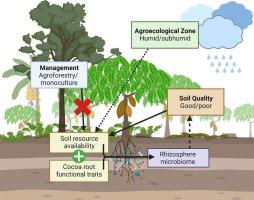当前位置:
X-MOL 学术
›
Appl. Soil Ecol.
›
论文详情
Our official English website, www.x-mol.net, welcomes your feedback! (Note: you will need to create a separate account there.)
Soil quality reflects microbial resource availability and drives rhizosphere microbiome variation in Ghanaian cocoa farms
Applied Soil Ecology ( IF 4.8 ) Pub Date : 2024-03-22 , DOI: 10.1016/j.apsoil.2024.105378 Jennifer Schmidt , Shalom D. Addo-Danso , Richard Asare , Abigail Tettey , Marney E. Isaac
Applied Soil Ecology ( IF 4.8 ) Pub Date : 2024-03-22 , DOI: 10.1016/j.apsoil.2024.105378 Jennifer Schmidt , Shalom D. Addo-Danso , Richard Asare , Abigail Tettey , Marney E. Isaac

|
Cocoa ( L.) is an important crop in Ghana and the source of livelihood for hundreds of thousands of smallholder farmers. Maintaining soil quality on these farms is critical to ensuring the long-term viability of cocoa farming and preventing deforestation to meet rising demand. However, increasing attention to soil health has revealed a significant knowledge gap related to the soil microbiome in cocoa production systems. Using a nested design of sixteen smallholder cocoa farms in agroforestry or monoculture, on different soil quality classes and in different agroecological zones, a study was conducted to identify 1) drivers of rhizosphere microbial diversity and community composition across scales and 2) the extent of microbial differentiation between soil quality classes. Soil quality had far greater impacts than agroecological zone or agroforestry vs. monoculture management on microbial diversity and community composition, accounting for 17 % of variation in prokaryotes and 10 % in fungi. Good-quality and poor-quality soils contrasted in soil and root parameters, creating variable microbial resources, which led to differences in microbial community composition and the relative abundance of specific taxa. Soil organic matter and root traits were key drivers of community composition in good-quality soils, while permanganate-oxidizable carbon was relatively more important in poor-quality soils. These results underscore the importance of considering rhizosphere microbial communities in assessments of soil quality and highlight taxa that may serve as biological indicators of soil health in cocoa agroforestry systems.
中文翻译:

土壤质量反映了微生物资源的可用性并驱动加纳可可农场根际微生物组的变化
可可 (L.) 是加纳的一种重要作物,也是数十万小农的生计来源。保持这些农场的土壤质量对于确保可可种植的长期生存和防止森林砍伐以满足不断增长的需求至关重要。然而,对土壤健康的日益关注揭示了可可生产系统中与土壤微生物组相关的重大知识差距。采用农林业或单一栽培、不同土壤质量等级和不同农业生态区的 16 个小农可可农场的嵌套设计,进行了一项研究,以确定 1) 跨尺度的根际微生物多样性和群落组成的驱动因素,以及 2) 微生物的范围土壤质量等级之间的区别。土壤质量对微生物多样性和群落组成的影响比农业生态区或农林业与单一栽培管理的影响要大得多,占原核生物变异的 17% 和真菌变异的 10%。优质土壤和劣质土壤在土壤和根系参数上存在差异,产生不同的微生物资源,从而导致微生物群落组成和特定类群相对丰度的差异。土壤有机质和根系性状是优质土壤中群落组成的关键驱动因素,而高锰酸盐可氧化碳在劣质土壤中相对更重要。这些结果强调了在评估土壤质量时考虑根际微生物群落的重要性,并强调了可作为可可农林复合系统土壤健康生物指标的类群。
更新日期:2024-03-22
中文翻译:

土壤质量反映了微生物资源的可用性并驱动加纳可可农场根际微生物组的变化
可可 (L.) 是加纳的一种重要作物,也是数十万小农的生计来源。保持这些农场的土壤质量对于确保可可种植的长期生存和防止森林砍伐以满足不断增长的需求至关重要。然而,对土壤健康的日益关注揭示了可可生产系统中与土壤微生物组相关的重大知识差距。采用农林业或单一栽培、不同土壤质量等级和不同农业生态区的 16 个小农可可农场的嵌套设计,进行了一项研究,以确定 1) 跨尺度的根际微生物多样性和群落组成的驱动因素,以及 2) 微生物的范围土壤质量等级之间的区别。土壤质量对微生物多样性和群落组成的影响比农业生态区或农林业与单一栽培管理的影响要大得多,占原核生物变异的 17% 和真菌变异的 10%。优质土壤和劣质土壤在土壤和根系参数上存在差异,产生不同的微生物资源,从而导致微生物群落组成和特定类群相对丰度的差异。土壤有机质和根系性状是优质土壤中群落组成的关键驱动因素,而高锰酸盐可氧化碳在劣质土壤中相对更重要。这些结果强调了在评估土壤质量时考虑根际微生物群落的重要性,并强调了可作为可可农林复合系统土壤健康生物指标的类群。



























 京公网安备 11010802027423号
京公网安备 11010802027423号